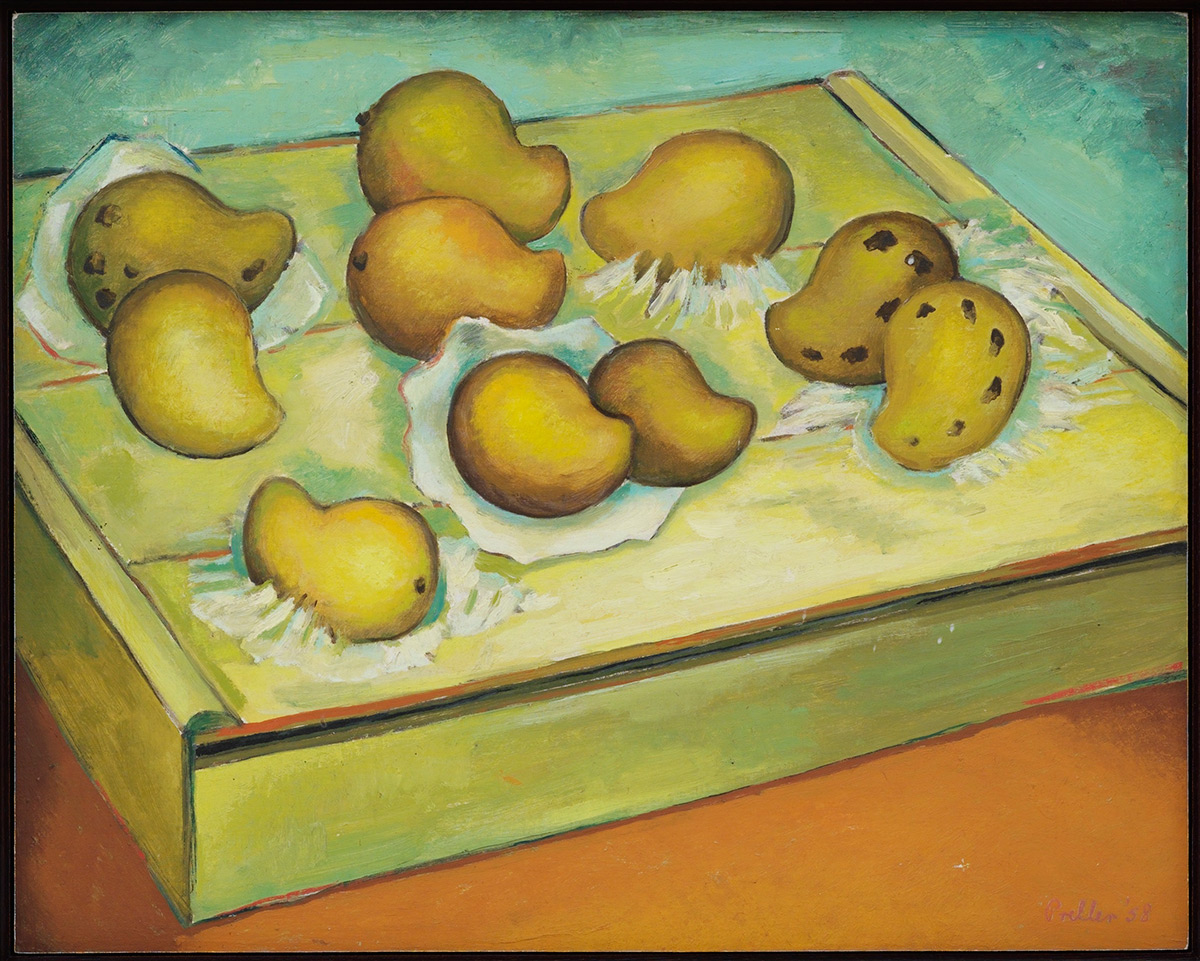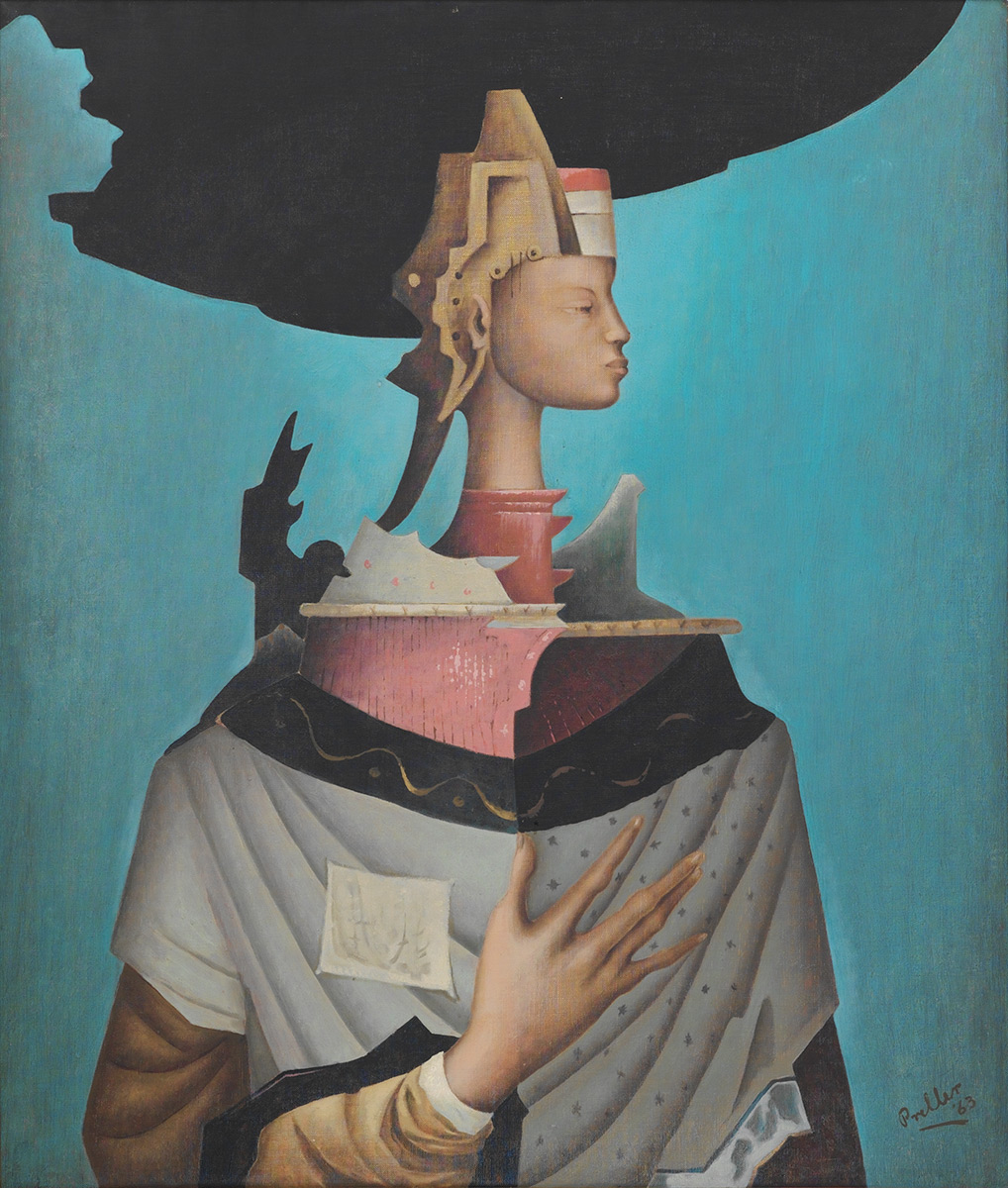Alexis PRELLER (1911 – 1975)
Profile Figure
1963
oil on canvas
103 x 87 cm
This hieratic work featuring a solitary, learned, mystic figure with a priest-like presence was painted by Alexis Preller at the height of his later unique style. Preller developed his own visual lexicon drawing on an array of elements from nature and the spiritual aspects of myriad cultures and mythologies, which he absorbed and transformed into his own hybrid iconography. His work was not always understood in the context of apartheid South Africa because it did not fit into any conventional old-school style and was not easy to label.
A substantial body of Preller’s work was featured in the exhibition Alexis Preller: Mythical Lexicon, curated by Karel Nel with support from Ally Martinez, which showed at Norval Foundation in 2024. The exhibition offered viewers insight into the ‘symbolic and fugue-like nature’ of Preller’s work. ‘Haunting, dreamlike images reappear over a lifetime, each repetition reconsidered and distilled, evoking a different and poetic order.’
‘Alexis Preller’s work is autobiographical on one hand, mythical, layered and culturally transformative on the other,’ reads the exhibition statement. ‘Solitary in nature, he worked in relative isolation, but his travels and continued interest in the art of other cultures sustained him and shaped his work. Deeply influenced by unknown artists across cultures and centuries, he drew on the hieratic traditions of Greece, Egypt and sub-Saharan Africa.’
BIOGRAPHY
Alexis Preller was born in Pretoria and went to school at Pretoria Boys High School, where he was always drawn to the theatre and was involved with many productions. He worked as a clerk before leaving for England to study at the Westminster School of Art in 1934. He went on to study at Académie de la Grande Chaumière in Paris (1937), where he visited studios, galleries and museums and found himself strongly drawn to the work of the French Post-Impressionists Vincent van Gogh and Paul Gaughin.
On his return to South Africa later that year, he spent some time camping in Swaziland (now eSwatini), where he produced a body of work that was later exhibited in Johannesburg, where a critic writing in the Rand Daily Mail dubbed him ‘the South African Gaughin’. However, his work during this period was also strongly influenced by the style of South African artist Irma Stern. Like Stern, he also visited Congo, which imprinted itself into his work.
In the mid-1940s, Preller returned to Europe, where he began to focus on the painting of still lifes, which he imbued with symbolic meaning in each object, from eggs to intricately carved figures. He experimented further with ritual and mystical themes, maintaining his interest in the Ndebele people, which began in the 1930s. Due mainly to his use of blue-green tones often contrasted with a fervent red, his work during this period is referred to as his ‘Blue Period’.
Preller fought in the Second World War, which greatly influenced his work. The experiences he underwent between 1939 and 1943 resulted in paintings of macabre subject matter, including disfigured and wounded bodies. Juxtaposed with these were more celestial elements of butterflies – a symbol of metamorphosis – and spiritual entities invoking a higher power beyond human logic. This style was heavily influenced by the European Surrealists of the 1920s and 30s.
In 1953, Preller travelled to Italy and to Egypt, where he was exposed to art of the Quattrocento (15th-century Renaissance) painting and Egyptian mythology. The combination of these frescoes and paintings with the symbolism and mystical ancestry of ancient Egypt affected Preller’s thinking.
By 1965, Preller had begun experimenting with non-figurative expression with a tendency to create works centred on the celestial in an abstract technique, decorated with gold leaf to emphasise the cosmological theme.
Although highly regarded in his native Pretoria, this was not initially the case elsewhere in South Africa. An exhibition of his works in Cape Town in the late 1960s was coolly received. His work was not always understood in the context of Apartheid South Africa because it did not fit into any conventional old-school style and was not easy to label.
By combining and transforming multiple influences and iconographies throughout his career, Preller developed his own unique syncretic style and visual lexicon. Drawing on an array of elements from nature and the spiritual aspects of myriad cultures and mythologies, he absorbed and transformed into his own hybrid iconography.
A substantial body of Preller’s work was featured in the exhibition Alexis Preller: Mythical Lexicon, curated by Karel Nel with support from Ally Martinez, at Norval Foundation in Cape Town (2024). The exhibition offered viewers insight into the ‘symbolic and fugue-like nature’ of Preller’s work. ‘Haunting, dreamlike images reappear over a lifetime, each repetition reconsidered and distilled, evoking a different and poetic order.’
‘Alexis Preller’s work is autobiographical on one hand, mythical, layered and culturally transformative on the other,’ reads the exhibition statement. ‘Solitary in nature, he worked in relative isolation, but his travels and continued interest in the art of other cultures sustained him and shaped his work. Deeply influenced by unknown artists across cultures and centuries, he drew on the hieratic traditions of Greece, Egypt and sub-Saharan Africa.’
Another major retrospective of his work, Africa, the sun and shadows was shown at Johannesburg’s Standard Bank Gallery in 2009. This was accompanied by a definitive two-volume biography and catalogue of his work, Alexis Preller: Africa, the sun and shadows and Collected Images, co-produced by art historian Esme Berman and curator, academic and artist Karel Nel.



